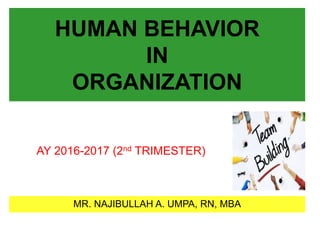
Chapter 12: Teambuilding
- 1. HUMAN BEHAVIOR IN ORGANIZATION MR. NAJIBULLAH A. UMPA, RN, MBA AY 2016-2017 (2nd TRIMESTER)
- 3. TEAM-BUILDING • With good team-building skills, you can unite employees around a common goal and generate greater productivity. Without them, you limit yourself and the staff to the effort each individual can make alone.
- 4. • Team building is an ongoing process that helps a work group evolve into a cohesive unit. The team members not only share expectations for accomplishing group tasks, but trust and support one another and respect one another's individual differences. • Your role as a team builder is to lead your team toward cohesiveness and productivity. A team takes on a life of its own and you have to regularly nurture and maintain it, just as you do for individual employees. • Managing diversity well can enhance team- building.
- 5. GUIDING PRINCIPLES Team building can lead to: • Good communications with participants as team members and individuals • Increased department productivity and creativity • Team members motivated to achieve goals • A climate of cooperation and collaborative problem- solving • Higher levels of job satisfaction and commitment • Higher levels of trust and support • Diverse co-workers working well together • Clear work objectives • Better operating policies and procedures
- 6. STEPS TO BUILDING AN EFFECTIVE TEAM The first rule of team building is an obvious one: to lead a team effectively, you must first establish your leadership with each team member. Remember that the most effective team leaders build their relationships of trust and loyalty, rather than fear or the power of their positions. • Consider each employee's ideas as valuable. Remember that there is no such thing as a stupid idea. • Be aware of employees' unspoken feelings. Set an example to team members by being open with employees and sensitive to their moods and feelings.
- 7. • Act as a harmonizing influence. Look for chances to mediate and resolve minor disputes; point continually toward the team's higher goals. • Be clear when communicating. Be careful to clarify directives. • Encourage trust and cooperation among employees on your team. Remember that the relationships team members establish among themselves are every bit as important as those you establish with them. As the team begins to take shape, pay close attention to the ways in which team members work together and take steps to improve communication, cooperation, trust, and respect in those relationships.
- 8. • Encourage team members to share information. Emphasize the importance of each team member's contribution and demonstrate how all of their jobs operate together to move the entire team closer to its goal. • Delegate problem-solving tasks to the team. Let the team work on creative solutions together.
- 9. • Facilitate communication. Remember that communication is the single most important factor in successful teamwork. Facilitating communication does not mean holding meetings all the time. Instead it means setting an example by remaining open to suggestions and concerns, by asking questions and offering help, and by doing everything you can to avoid confusion in your own communication.
- 10. • Establish team values and goals; evaluate team performance. Be sure to talk with members about the progress they are making toward established goals so that employees get a sense both of their success and of the challenges that lie ahead. Address teamwork in performance standards. Discuss with your team: – What do we really care about in performing our job? – What does the word success mean to this team? – What actions can we take to live up to our stated values?
- 11. • Make sure that you have a clear idea of what you need to accomplish; that you know what your standards for success are going to be; that you have established clear time frames; and that team members understand their responsibilities. • Use consensus. Set objectives, solve problems, and plan for action. While it takes much longer to establish consensus, this method ultimately provides better decisions and greater productivity because it secures every employee's commitment to all phases of the work.
- 12. • Set ground rules for the team. These are the norms that you and the team establish to ensure efficiency and success. They can be simple directives (Team members are to be punctual for meetings) or general guidelines (Every team member has the right to offer ideas and suggestions), but you should make sure that the team creates these ground rules by consensus and commits to them, both as a group and as individuals.
- 13. • Establish a method for arriving at a consensus. You may want to conduct open debate about the pros and cons of proposals, or establish research committees to investigate issues and deliver reports.
- 14. • Encourage listening and brainstorming. As supervisor, your first priority in creating consensus is to stimulate debate. Remember that employees are often afraid to disagree with one another and that this fear can lead your team to make mediocre decisions. When you encourage debate you inspire creativity and that's how you'll spur your team on to better results.
- 15. SYMPTOMS THAT SIGNAL A NEED FOR TEAM BUILDING • Decreased productivity • Conflicts or hostility among staff members • Confusion about assignments, missed signals, and unclear relationships • Decisions misunderstood or not carried through properly • Apathy and lack of involvement
- 16. SYMPTOMS THAT SIGNAL A NEED FOR TEAM BUILDING • Lack of initiation, imagination, innovation; routine actions taken for solving complex problems • Complaints of discrimination or favoritism • Ineffective staff meetings, low participation, minimally effective decisions • Negative reactions to the manager • Complaints about quality of service